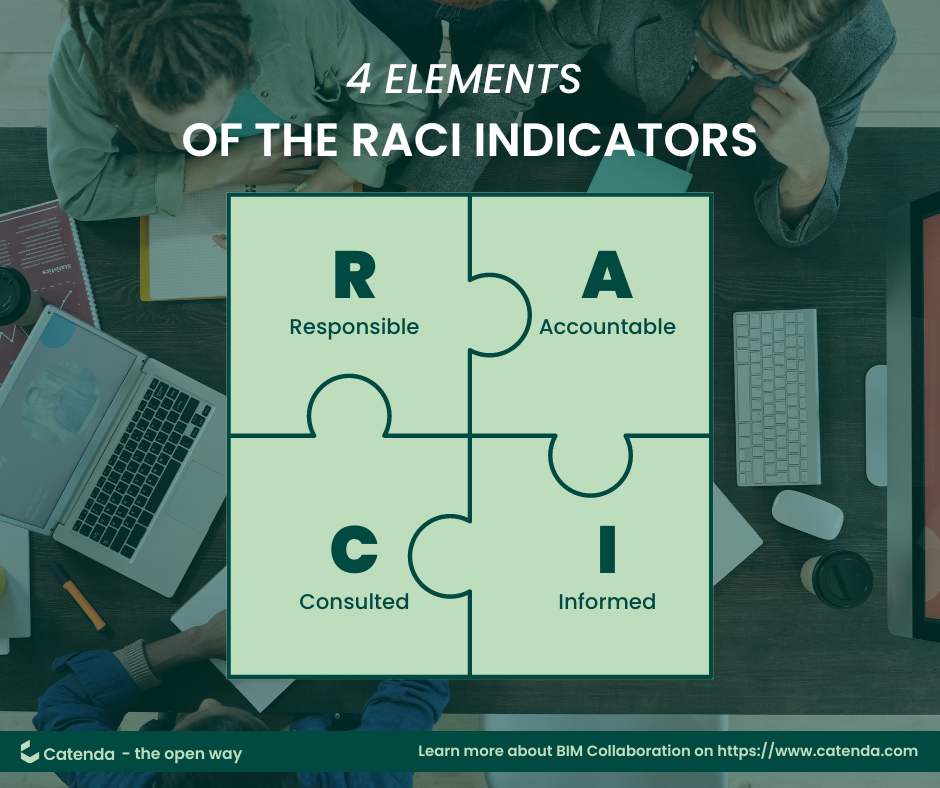What is RACI model?

What does RACI mean?
RACI is a terminology standing for responsible, accountable, consulted and informed. Each element of RACI model is associated with a specific role in the BIM (Building Information Modeling) project.
What is it that defines the four roles of a RACI chart, and what are these roles in project management?
Responsible
This type of role refers to a project manager or a team member who is in charge of successfully carrying out the tasks, milestones and deliverables.
Accountable
Accountable person taking on this role is often a senior leader who has the ultimate authority on how tasks and deliverables should be accomplished.
Consulted
The individual in this role acts as an advisor who comes up with different insights and opinions to consult the team about a specific subject or task.
Informed
Informed project members can be a client or an employee who is not directly involved, but it is necessary to update them on the status of current performance and the progress of a project.
By combining 4 clearly defined functions, the RACI model is a useful matrix widely used for project management and BIM project implementation, as well.
What are the benefits of the RACI Indicator?
Putting an end to redundant work and optimizing project resources
The RACI chart helps teams avoid overlapping and ensures that the resources will be effectively allocated to the right person with responsibility. As a result, all the missions can be perfectly covered within a given condition and the engine is set in motion toward the ultimate goals.
Eliminating the responsibility and authority conflict among involved stakeholders
Participating in the project, each individual is assigned a specific role. Therefore, when it comes to task completion and decision-making, stakeholders will behave professionally, as discussed at the beginning.
Boosting effective communication
The RACI model was solidly structured with 4 equal pillars to facilitate information sharing and insight exchanges among different roles in the project. By doing so, the expected results are clearly determined at the early stage, which enables a smoothly-operated and well-performed project.
How to create a decent RACI matrix
5 steps to follow when building your own RACI matrix
There are various tools and templates available for modelling an RACI diagram, ranging from simple and easy-to-use ones like spreadsheets from Microsoft Excel or Google Sheets and whiteboards to more advanced and technical solutions such as software. However, no matter which types of template and tool you choose, it is critical to involve all of your team in different roles in contributing to the process.
Step 1 – Identify the Project roles
First of all, you formulate a list of involved stakeholders including their names and the roles they play in the project, associating with R, A, C, or I to ground the matrix. In many cases, one name per role is considered optimal.
Step 2 – Pin down the Project Tasks, Milestones and Deliverables
The second step highlights the importance of communication and mutual agreement on expected results within the team members from the very beginning. You should organize meetings, round-table discussions or events for key stakeholders to define significant tasks and tangible deliverables they insist on achieving in the end. Based on that, you can have a clear and complete set of tasks to implement in the next steps.
Step 3 – Assign the right tasks to the right role
Now you are having 2 sets in your hands – tasks and roles. Your mission is to review thoroughly your resource allocation and give the people in the role of R, A, C or I the tasks that best fit them. In this step, there are some tips and best practices that you should keep in mind.
- Only one name can be assigned to Accountable
- Each task ideally has a Responsible and Accountable party, at least
Step 4 – Form the alignment on assigned tasks and roles within the team
After setting up the system, it is time to have a meeting with all the actors and stakeholders to make sure that everything is aligned correctly and there is no disagreement and misunderstanding on the execution phase. Once you get buy-in, the BIM project will definitely be running smoothly.
Step 5 – Get feedback and analyse to improve the RACI diagram throughout the project
The project will evolve, meaning that you have to constantly pay attention to comments and feedback of your team members and adapt your RACI matrix to the current situation. By doing this, you can resolve any arising conflicts in a timely fashion, correct active tasks according to feedback if needed and control the progress at your best.
Do and don’t when creating an RACI matrix
Do
- Clarify specific reasons why an RACI matrix is instrumental and beneficial to your BIM project and your organization
- Maintain the transparency to make sure that everyone in your team is informed and fully aware of both their assignments and any changes happening
- Find and adopt the right RACI template for your BIM project
Don’t
- Don’t work on the RACI diagram only by yourself, but instead encourage your group of teammates to join and share their feedback and ideas
- Don’t let many consultants get involved in your project, to avoid time-consuming actions and meet the due dates
- Don’t overwhelm your team members with tasks or unnecessary information.
If you are not a big fan of RACI framework, here are the 2 alternatives that you can consider
The most used alternatives to the RACI are PACSI and RAPID
PACSI
PACSI allows multiple individuals to review the work of an accountable person. There are 5 different roles in the matrix, which are Performed, Accountable, Control, Suggested, and Informed.
RAPID
Invented by Bain & Company, RAPID helps clarify decision accountability through role and responsibility delineation. Recommend, Agree, Perform, Input, and Decide are the indicators of this model.



